Artículos SCI
2014
2014
Materiales Nanoestructurados y Microestructura - Nanotecnología en Superficies y Plasma
Simultaneous quantification of light elements in thin films deposited on Si substrates using proton EBS (Elastic Backscattering Spectroscopy)
Ferrer, FJ; Alcaire, M; Caballero-Hernandez, J; Garcia-Garcia, FJ; Gil-Rostra, J; Terriza, A; Godinho, V; Garcia-Lopez, J; Barranco, A; Fernandez-Camacho, ANuclear Instruments and Methods in Physics Research Section B: Beam Interactions with Materials and Atoms, 332 (2014) 449-453
Show abstract ▽
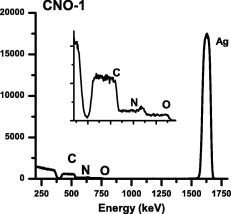
Quantification of light elements content in thin films is an important and difficult issue in many technological fields such as polymeric functional thin films, organic thin film devices, biomaterials, and doped semiconducting structures.
Light elements are difficult to detect with techniques based on X-ray emission, such as energy dispersive analysis of X-rays (EDAX). Other techniques, like X-ray photoelectron spectroscopy (XPS), can easily quantify the content of light elements within a surface but often these surface measurements are not representative of the lights elements global composition of the thin film. Standard Rutherford backscattering spectroscopy (RBS), using alpha particles as probe projectiles, is not a good option to measure light elements deposited on heavier substrates composed of heavier elements like Si or glass. Nuclear Reaction Analysis (NRA) offers a good quantification method, but most of the nuclear reactions used are selective for the quantification of only one element, so several reactions and analysis are necessary to measure different elements.
In this study, Elastic Backscattering Spectroscopy (EBS) using proton beams of 2.0 MeV simultaneously quantified different light elements (helium, carbon, nitrogen, oxygen, and fluorine) contained in thin films supported on silicon substrates. The capabilities of the proposed quantification method are illustrated with examples of the analysis for a series of thin film samples: amorphous silicon with helium bubbles, fluorinated silica, fluorinated diamond-like carbon and organic thin films. It is shown that this simple and versatile procedure allows the simultaneous quantification of light elements in thin films with thicknesses in the 200–500 nm range and contents lower than 10 at.%.
Agosto, 2014 | DOI: 10.1016/j.nimb.2014.02.124
Materiales Coloidales
New Single-Phase, White-Light-Emitting Phosphors Based on delta-Gd2Si2O7 for Solid-State Lighting
Fernandez-Carrion, AJ; Ocana, M; Garcia-Sevillano, J; Cantelar, E; Becerro, AIJournal of Physical Chemistry C, 118 (2014) 18035-18043
Show abstract ▽
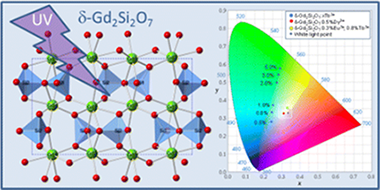
Two new white-light (WL)-emitting phosphors (δ-Gd2Si2O7:Dy and δ-Gd2Si2O7:Eu,Tb) have been synthesized by the sol–gel method. The Gd-Ln3+ (Ln3+= Dy3+, Tb3+, Eu3+) energy-transfer band has been used to excite both phosphors, which provides an enhancement of the Ln3+ emissions. First, WL was generated from δ-Gd2Si2O7:xDy thanks to the particular ratio of the blue and yellow emissions observed in all three compositions, which had chromatic coordinates of x = 0.30, y = 0.33 and CCT values of between 7077 and 6721 K. The decay curves of the main transitions of Dy3+ showed a maximum lifetime value for δ-Gd2Si2O7:0.5%Dy, which is, therefore, the most efficient doping level. Second, a broad spectral range, single-phase, WL-emitting phosphor was generated by codoping δ-Gd2Si2O7 with Tb3+ and Eu3+. The composition δ-Gd2Si2O7:0.3%Eu3+;0.8%Tb3+ showed CIE coordinates well inside the ideal WL region of the CIE diagram and a CCT value of 5828 K. The single-phase WL-emitting phosphors presented in this paper are promising materials to be used in white solid-state lighting systems and field-emission displays due to the advantages provided both by Gd3+ ions and by the high thermal and chemical stabilities of the rare earth disilicate matrix.
Agosto, 2014 | DOI: 10.1021/jp505524g
Nanotecnología en Superficies y Plasma
Bending Induced Self-Organized Switchable Gratings on Polymeric Substrates
Parra-Barranco, J; Oliva-Ramirez, M; Gonzalez-Garcia, L; Alcaire, M; Macias-Montero, M; Borras, A; Frutos, F; Gonzalez-Elipe, AR; Barranco, AACS Applied Materials & Interfaces, 6 (2014) 11924-11931
Show abstract ▽
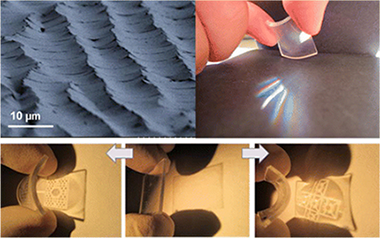
We present a straightforward procedure of self-surface patterning with potential applications as large area gratings, invisible labeling, optomechanical transducers, or smart windows. The methodology is based in the formation of parallel micrometric crack patterns when polydimethylsiloxane foils coated with tilted nanocolumnar SiO2 thin films are manually bent. The SiO2 thin films are grown by glancing angle deposition at room temperature. The results indicate that crack spacing is controlled by the film nanostructure independently of the film thickness and bending curvature. They also show that the in-plane microstructural anisotropy of the SiO2 films due to column association perpendicular to the growth direction determines the anisotropic formation of parallel cracks along two main axes. These self-organized patterned foils are completely transparent and work as customized reversible diffraction gratings under mechanical activation.
Agosto, 2014 | DOI: 10.1021/am5037687
Reactividad de Sólidos
Scission kinetic model for the prediction of polymer pyrolysis curves from chain structure
Perez-Maqueda, LA; Sanchez-Jimenez, PE; Perejon, A; Garcia-Garrido, C; Criado, JM; Benitez-Guerrero, MPolymer Testing, 37 (2014) 1-5
Show abstract ▽
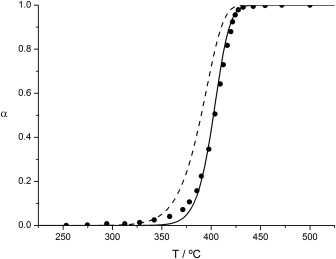
There is a significant interest in correlating polymer structure with thermal degradation behavior. Thus, polymer pyrolysis curves could be predicted from the chemical structure of the polymer. Recent proposals correlate the kinetic temperature function directly with the chemical structure of the polymer by means of the dissociation energy while assuming a semi-empirical first order model for the reaction fraction function. However, a first order model lacks physical meaning and produces significant deviations of the predicted curves, mostly under isothermal conditions. Thus, in this work, an upgrade of the method is proposed by using a new random scission kinetic model. The newly proposed kinetic equation has been checked by fitting the experimental data reported by different authors for the thermal pyrolysis of polystyrene. It has been demonstrated that it accounts for the experimental data of polymer degradation under different heating schedules with considerably higher precision than the previously assumed first order kinetics.
Agosto, 2014 | DOI: 10.1016/j.polymertesting.2014.04.004
Reactividad de Sólidos
Relevant Influence of Limestone Crystallinity on CO2 Capture in The Ca-Looping Technology at Realistic Calcination Conditions
Valverde, JM; Sanchez-Jimenez, PE; Perez-Maqueda, LAEnvironmental Science & Technology, 48 (2014) 9882-9889
Show abstract ▽
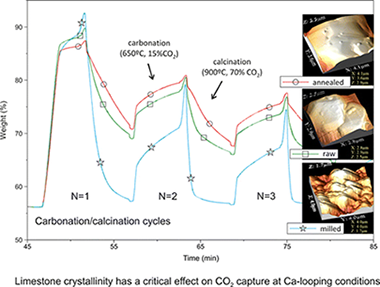
We analyze the role of limestone crystallinity on its CO2 capture performance when subjected to carbonation/calcination cycles at conditions mimicking the Ca-looping (CaL) technology for postcombustion CO2 capture. The behavior of raw and pretreated limestones (milled and thermally annealed) is investigated by means of thermogravimetric analysis (TGA) tests under realistic sorbent regeneration conditions, which necessarily involve high CO2 partial pressure in the calciner and quick heating rates. The pretreatments applied lead to contrasting effects on the solid crystal structure and, therefore, on its resistance to solid-state diffusion. Our results show that decarbonation at high CO2 partial pressure is notably promoted by decreasing solid crystallinity. CaO regeneration is fully achieved under high CO2 partial pressure at 900 °C in short residence times for the milled limestone whereas complete regeneration for raw limestone requires a minimum calcination temperature of about 950 °C. Such a reduction of the calcination temperature and the consequent mitigation of multicyclic capture capacity decay would serve to enhance the efficiency of the CaL technology. On the other hand, the results of our study suggest that the use of highly crystalline limestones would be detrimental since excessively high calcination temperatures should be required to attain full decarbonation at realistic conditions.
Agosto, 2014 | DOI: 10.1021/es5014505
- ‹ anterior
- 269 of 420
- siguiente ›














